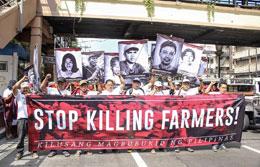Philippines tops bloody year of land-rights killings

More than two people were killed every week on average this year defending their right to land and resources, with the Philippines recording the highest number of casualties amid a government crackdown on rural communities, a rights group said.
In the fight for land and the environment, communities around the world are locked in deadly struggles against governments, companies and criminal gangs exploiting land for products including timbre, minerals and palm oil.
At least 116 people were killed between January 1 and November 30, according to advocacy group PAN Asia Pacific (PANAP). The victims included farmers, indigenous people and activists, with women making up a tenth of the total.
The Philippines accounted for 61 victims, followed by Brazil with 22, said the report.
This has been “yet another year of continuing and intensifying attacks against rural communities that are asserting their right to land and resources”, the report said.
“Alarmingly, global and regional developments that create conditions for greater land and resource grabbing continue to emerge and fuel social conflicts and unrest in rural areas.” The number of victims this year is lower than the 171 killed in the same period last year, PANAP’s data showed.
A separate estimate by UK-based advocacy group Global Witness puts the number of victims at 170 so far this year.
The final tally could equal, or exceed that of 2016, which was the deadliest year on record with about 200 deaths, a spokeswoman told the Thomson Reuters Foundation.
In Asia, land rights defenders were also killed in India and Myanmar, and in Latin America, killings were recorded in Mexico, Peru, Colombia, Guatemala and Venezuela, according to PANAP.
More than half the rights violations — including threats, assaults, arrests and displacement — involved mining companies.
Plantations, power plants, infrastructure projects and real estate developments were also hot spots for violations.
In the Philippines, killings and other forms of repression targeting farmers, indigenous peoples and activists “spiked dramatically”, with massive displacements of rural communities set to continue, the report said.
Harassment of women land activists in Southeast Asia is on the rise, the report said, while in Myanmar, the government has taken over vast swathes of land in Rakhine state after driving out hundreds of thousands of Rohingya.
China’s multi-trillion dollar Belt and Road Initiative, which aims to recreate the old Silk Road with massive infrastructure projects connecting China to Europe and beyond, will also see land grabs and huge displacements, PANAP said.
PAN Asia Pacific (PANAP), through the reports of our partners and networks and based on our regular monitoring of news and developments, has recorded a total of 142 cases of human rights violations related to land conflicts and struggles in 21 countries from various regions covering the period January 1 to November 30, 2017:
Meanwhile, NGO Amnesty International said India is among the deadliest countries for defenders of rights related to land, territory and the environment.
In its global report ‘Deadly but Preventable Attacks: Killings and Enforced Disappearances of Those who Defend Human Rights’, , the rights watchdog said: “In India, journalists, land rights activists, and those advocating the rights of ethnic and religious minorities, Dalits and Adivasis (tribal) are among those at risk of attack.”
According to an Amnesty release, as many as 3,500 human rights defenders were killed worldwide since 1998 while the number in 2016 was 281-- a significant increase from 156 defenders killed in 2015 and 136 in 2014.
Also, 48 journalists were killed worldwide in 2016, according to the Committee to Protect Journalists.
Asmita Basu, Programmes Director at Amnesty International India, said human rights defenders were painted as a threat to development or traditional values.
“Human rights defenders, instead of being recognised and protected by the state, are portrayed as ‘criminals’, ‘foreign agents’, ‘anti-nationals’ and ‘terrorists’, and painted as a threat to development or traditional values. Such labels are divisive, signal contempt for constitutional rights, and give a green light to further abuses,” she said, as per the release.
The report has brought together stories from around the world including that of journalist Gauri Lankesh, who was fatally shot outside her home in Bengaluru in September 2017.
It also mentioned Chhattisgarh’s Jailal Rathia, who had challenged the Adivasi land grabbing and later died of what was suspected as deliberate poisoning, and killing of Maharashtra Dalit activist Chandrakant Gaikwad.
The report focused on the gravest of violations against human rights defenders-- killings and enforced disappearances.
“The motives behind these attacks are multiple and layered. Some people are attacked because of their legitimate activities, for example, as they stand up to powerful actors violating human rights, share information and raise awareness, or confront discriminatory public opinion and social norms. Others are attacked both for what they do and who they are,” it said.
The human rights defenders included those defending the rights of women, lesbian, gay, bisexual, transgender and intersex people and indigenous peoples and minority groups, it added.






